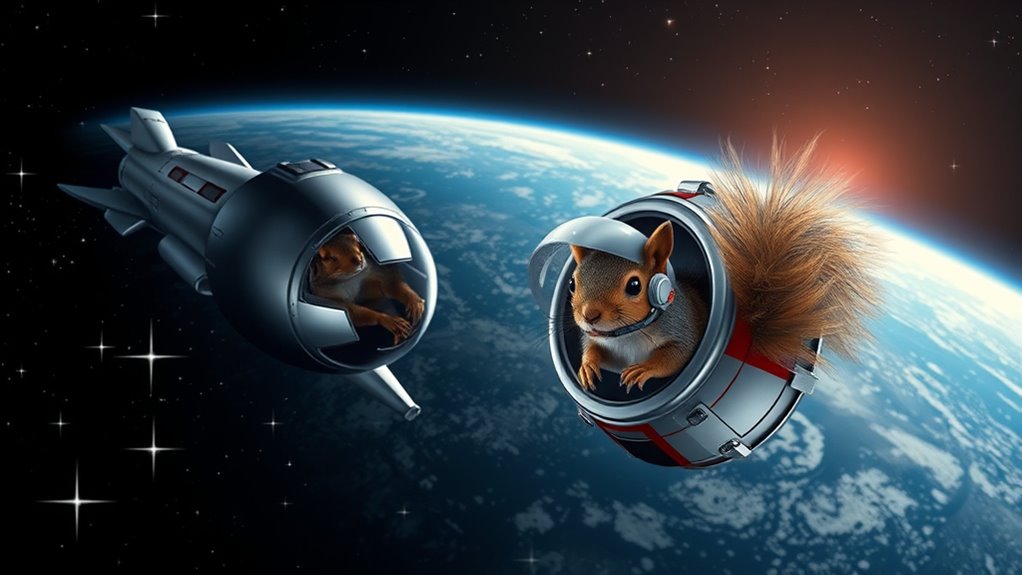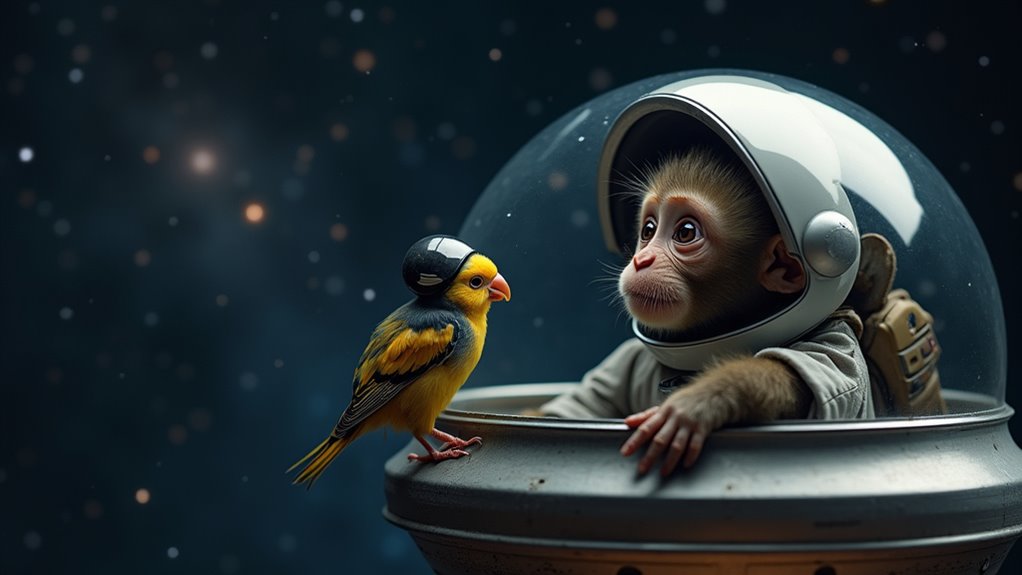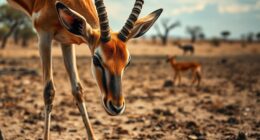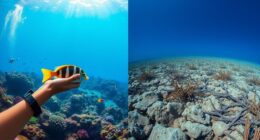Animals have been vital in space exploration, helping scientists understand how microgravity affects living beings. From dogs like Laika to mice and monkeys, they’ve endured experiments that revealed impacts on bones, muscles, and the heart. Despite risks and sacrifices, their journeys paved the way for human space travel and safer missions. If you continue exploring, you’ll discover inspiring stories and breakthroughs behind these brave animal astronauts.
Key Takeaways
- Animals like Laika, mice, dogs, and monkeys were sent into space to study biological responses to microgravity and radiation.
- Animal training included teaching tolerance to confinement and performing simple tasks to ensure safety during missions.
- Experiments revealed effects like bone loss, muscle atrophy, and cardiovascular changes in microgravity environments.
- Many animals sacrificed their lives, advancing space science and paving the way for human space travel safety.
- Their contributions laid the foundation for modern space biology, using animals to understand and mitigate space-related health risks.

Have you ever wondered how scientists learned what happens to living organisms in space? It all started with space animal experiments, a series of tests designed to understand how microgravity and radiation affect biological systems. These experiments often involved sending small animals, like mice, dogs, and monkeys, into space to observe their responses. But before any animal could venture beyond Earth’s atmosphere, they had to go through animal astronaut training. This training prepared them for the unique challenges of space travel, ensuring they could survive and perform their roles during the mission.
Animal astronaut training was essential because it helped scientists determine how animals might react to the stresses of space. It included teaching animals to tolerate confinement, familiarizing them with the sounds and vibrations of spacecraft, and ensuring they could perform simple tasks. For instance, some animals learned to press levers or respond to stimuli, which provided insights into their cognitive functions and stress levels. This training also aimed to make their journeys as humane as possible, minimizing discomfort and ensuring their safety. Additionally, researchers developed specific protocols to monitor the animals’ health throughout the missions, emphasizing the importance of animal welfare during space exploration. Understanding how to care for animals in space has been crucial in advancing space biology research. Moreover, ongoing improvements in animal training techniques have contributed to safer and more effective missions.
Animal astronaut training prepared creatures for space stresses, ensuring safety and humane treatment during missions.
Through space animal experiments, scientists gained invaluable knowledge about biological processes in space. For example, they studied how bone density decreases in microgravity, how muscle atrophy occurs, and how the cardiovascular system adapts. These experiments not only helped understand the effects of space on living organisms but also informed medical research that benefits humans on Earth. The data gathered from these animals contributed to developing countermeasures to protect astronauts during long missions, such as those to Mars. The use of animal models in space research has significantly advanced our understanding of human health in space environments.
The journey of animal astronauts was often perilous. Many animals didn’t survive their missions, but their sacrifices paved the way for human space exploration. For example, Laika, the first dog in space, became a symbol of scientific progress, despite the tragic outcome of her flight. Her mission proved that living beings could endure space travel, inspiring further research and improvements in animal astronaut training. Over time, more sophisticated experiments and better training methods reduced risks, and animals became key members of space research teams, providing indispensable data without risking human lives.
Today, the legacy of space animal experiments and animal astronaut training continues to influence space science. While we now rely more on robotic models and computer simulations, animals played a pivotal role in pioneering our understanding of space’s impact on living organisms. Their stories remind us of the brave, often unseen sacrifices made in the pursuit of discovery, helping humanity reach farther into the cosmos.
Frequently Asked Questions
How Did Animals Influence Human Space Exploration Policies?
You see, animals greatly influenced human space exploration policies by highlighting the importance of animal welfare and ensuring safety measures are in place. Their participation in early missions provided vital scientific advancements, allowing scientists to understand the effects of space travel on living organisms. This knowledge led to improved procedures and ethical standards, ultimately shaping policies that prioritize both scientific progress and the humane treatment of animals involved in space research.
What Ethical Debates Surround Animal Testing in Space?
You’re walking a tightrope when considering animal testing in space, balancing scientific necessity with animal rights. Ethical debates focus on whether it’s right to use animals for experiments that may cause harm or distress. Critics argue it’s a moral gray area, while supporters see it as essential for progress. You must weigh the potential benefits against the ethical costs, knowing that progress often comes with difficult choices.
Were Any Animals Harmed During Space Missions?
You wonder if any animals were harmed during space missions. While animal training and space mission logistics aimed to guarantee safety, some animals did face risks. For example, during early missions like Laika’s, there was limited knowledge about life support, and unfortunately, some animals didn’t survive. Today, strict protocols help protect animal welfare, but past missions remind us of the ethical challenges involved in space exploration.
How Did Animals Adapt to Zero Gravity Environments?
You might wonder how animals adapt to zero gravity environments. Their space adaptation involves biological responses like fluid redistribution, muscle atrophy, and changes in balance, all due to the absence of gravity. Scientists observe these reactions to understand how living organisms cope with microgravity. By studying these biological responses, you gain insights into the challenges animals face in space, helping improve future long-term space missions for both animals and humans.
What Species Are Considered for Future Space Colonization?
Imagine a blueprint for life on Mars, where you consider resilient species for colonization. You might focus on animals suited for extreme environments, like genetically engineered lizards or microbes, symbolizing adaptability. These species could support Mars colonization efforts by aiding in ecological balance. You explore animal genetic engineering to enhance survival traits, ensuring future explorers and habitats thrive, turning the red planet into a new home for both humans and resilient animals.
Conclusion
So, next time you look up at the night sky, remember that some of the first explorers were animals, just like you and me. It’s funny how a tiny mouse or a brave dog helped open the mysteries of space, almost like they were waiting for us to catch up. Their stories remind you that curiosity and courage often come in unexpected packages, making their journeys feel a little more personal—like they were part of your own adventure too.










